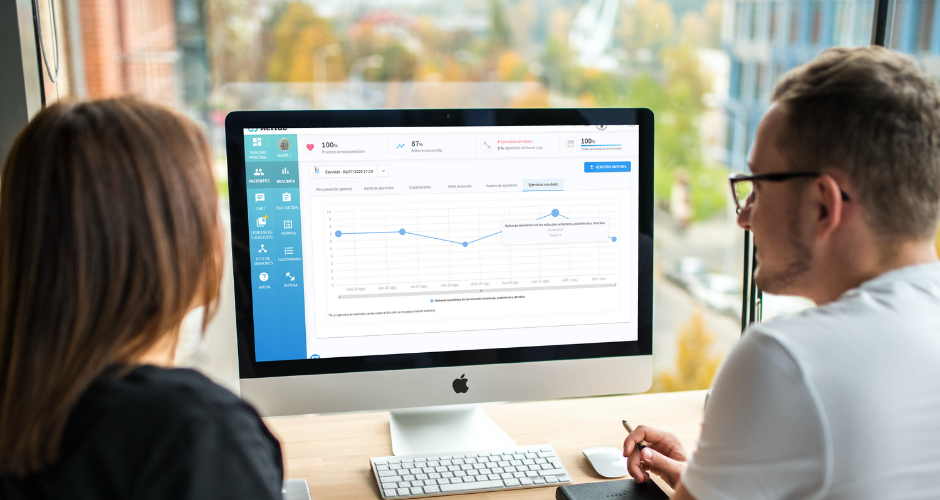After almost two years of the pandemic, there is no doubt that the digital transformation of the health sector is here to stay. The need to offer remote services and the urgency to improve processes to relieve the health system have been the definitive catalysts for a paradigm shift announced years ago.
In this article, we explain 5 trends in digital health that will be protagonists during this year 2022.
1. Remote monitoring: personal health data
According to Deloitte's "Predictions TMT 2022" report, in 2022 there will be 330 million wearable devices for healthcare, a spectacular figure that will almost reach 500 million in 2024.
Wearable devices are capable of measuring biometric and health data and are getting smaller, more accurate, and smarter. The rapid technological progress in the development of these devices and their software means that today anyone can gather useful information by monitoring their health status.
Although it is clear that this "explosion" in collecting health data must be taken with caution and despite the fact that a medical diagnosis must always be validated by health professionals, it is also true that thanks to the advancements in hardware and software capabilities, it is increasing. Therefore, these wearable devices should be seriously considered by the health providers to integrate them as part of the health diagnosis and treatment of patients, thus helping to track and monitor in real-time, especially chronic patients.
For example, Lynx uses inertial sensors to make it easier for physical therapists and rehabilitation physicians to perform functional assessments of patients with musculoskeletal problems.
2. Big data in healthcare: security and privacy challenges
One of the consequences of digitization in healthcare is the exponential increase in the volume of medical data, which opens up a lot of possibilities for the present and future of medicine. One of the most urgent challenges in digital health is to ensure the privacy and security of personal data.
Beyond economic interests, the regulatory authorities must work so that open data and interoperability of medical data (essential for scientific progress) do not compromise the right to privacy.

In Europe, steps are already being taken in this direction, and one of the objectives of the European Commission for the 2019-2025 period is the creation of a European space for health data that facilitates the exchange, guaranteeing compliance with the GDPR in all European countries.
At the same time, the increase in cyberattacks that affect health systems increases the need for health infrastructures to reinforce their security protocols to prevent the loss of sensitive data.
3. Cloud computing and artificial intelligence: present and future
The real value and potential of a large amount of medical data available depend on its correct management and analysis, and that is where technologies and techniques such as artificial intelligence or cloud computing come into play.
The use cases of artificial intelligence are very broad in the field of digital health, and range from the faster development of new drugs thanks to better simulations to the more precise and useful understanding of medical data, facilitating decision-making for diagnosis and treatments.
Cloud computing facilitates real-time access and sharing of medical data. Using supercomputers, you can accelerate the data analysis and processing to any research team, avoiding the need to invest in expensive computer equipment.
4. Telemedicine: beyond video calls and chat messages
Telemedicine has made great strides during the pandemic, by avoiding the risks of face-to-face visits and allowing continuity of medical services, remotely. So, many people have become accustomed to the comfort of being able to resolve doubts and be attended from home, which increases confidence and satisfaction with telemedicine.

Physical rehabilitation has also benefited from these new health services. For example, with telerehabilitation professionals can design therapeutic exercises and follow up patients' progress remotely. So, they can include more patients in their rehabilitation service.

Other professionals combine digital therapy with face-to-face therapy, especially for patients who are not too digital or are not so confident with new technologies. A great use case of this healthcare model is Vall Hebron Hospital, which is using telerehabilitation services to reduce waiting lists of patients with chronic musculoskeletal problems.
5. Automation: increasing efficiency into healthcare management
When a patient needs to seek treatment or diagnosis through several departments or facilities, the transfer of patient data can lead to bottlenecks. On the other hand, a study reveals that 65% of physicians feel more overworked today than when they started their careers, compared to just 13 percent of doctors who feel less overworked.
With automation, healthcare professionals can reduce human error and mistakes. It also saves time, reduces administrative work, and improves efficiency. These advantages will help to provide more effective treatments. So, healthcare professionals will have additional digital health tools for analyzing, diagnosing, and treating their patients.
A good example is administrative work. Although it is essential for the proper working of the healthcare system, it takes a lot of hours. That is where digitization comes in. Many professionals are already using automation at the front desk. In some clinics, patients can check-in without needing to interact with a receptionist. They can simply sign the necessary forms electronically on a tablet.
-1.png?width=700&height=350&name=Dise%C3%B1o%20sin%20t%C3%ADtulo%20(6)-1.png)
.png?width=1092&height=497&name=RehubbyDycare_cobalto%20(4).png)